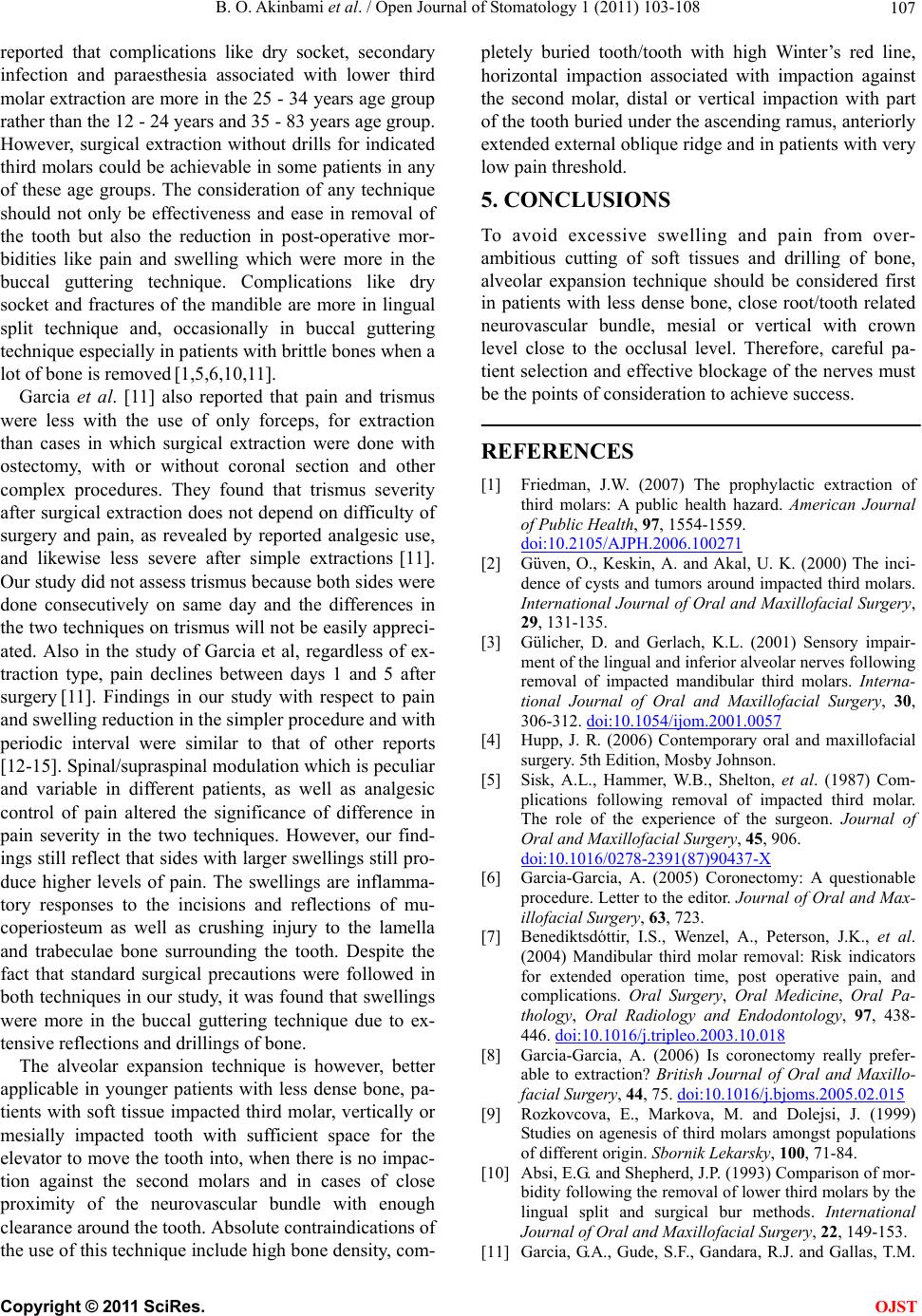
B. O. Akinbami et al. / Open Journal of Stomatology 1 (2011) 103-108 107
reported that complications like dry socket, secondary
infection and paraesthesia associated with lower third
molar extraction are more in the 25 - 34 years age group
rather than the 12 - 24 years and 35 - 83 years age group.
However, surgical extraction without drills for indicated
third molars could be achievable in some patients in any
of these age groups. The consideration of any technique
should not only be effectiveness and ease in removal of
the tooth but also the reduction in post-operative mor-
bidities like pain and swelling which were more in the
buccal guttering technique. Complications like dry
socket and fractures of the mandible are more in lingual
split technique and, occasionally in buccal guttering
technique especially in p atients with brittle bones when a
lot of bone is removed [1,5,6,10,1 1].
Garcia et al. [11] also reported that pain and trismus
were less with the use of only forceps, for extraction
than cases in which surgical extraction were done with
ostectomy, with or without coronal section and other
complex procedures. They found that trismus severity
after surgical extraction does not depend on difficulty of
surgery and pain, as revealed by reported analgesic use,
and likewise less severe after simple extractions [11].
Our study did not assess trismus because both sides were
done consecutively on same day and the differences in
the two techniques on trismus will not be easily appreci-
ated. Also in the study of Garcia et al, regardless of ex-
traction type, pain declines between days 1 and 5 after
surgery [11]. Findings in our study with respect to pain
and swelling reduction in the simpler proc edur e and with
periodic interval were similar to that of other reports
[12-15]. Spinal/supraspin al modulation which is pecu liar
and variable in different patients, as well as analgesic
control of pain altered the significance of difference in
pain severity in the two techniques. However, our find-
ings still reflect that sides with larger swellings still pro-
duce higher levels of pain. The swellings are inflamma-
tory responses to the incisions and reflections of mu-
coperiosteum as well as crushing injury to the lamella
and trabeculae bone surrounding the tooth. Despite the
fact that standard surgical precautions were followed in
both techniques in our study, it was found that swellings
were more in the buccal guttering technique due to ex-
tensive reflections and drillings of bone.
The alveolar expansion technique is however, better
applicable in younger patients with less dense bone, pa-
tients with soft tissue impacted third molar, vertically or
mesially impacted tooth with sufficient space for the
elevator to move the too th into, when there is no impac-
tion against the second molars and in cases of close
proximity of the neurovascular bundle with enough
clearance around the tooth. Absolute contraindications of
the use of this technique include high bone density, com-
pletely buried tooth/tooth with high Winter’s red line,
horizontal impaction associated with impaction against
the second molar, distal or vertical impaction with part
of the tooth buried under the ascending ramus, anteriorly
extended extern al obliqu e ridge and in patien ts with very
low pain thres hold.
5. CONCLUSIONS
To avoid excessive swelling and pain from over-
ambitious cutting of soft tissues and drilling of bone,
alveolar expansion technique should be considered first
in patients with less dense bone, close root/tooth related
neurovascular bundle, mesial or vertical with crown
level close to the occlusal level. Therefore, careful pa-
tient selection and effective blockage of the nerv es must
be the points of co nsideration to achieve success.
REFERENCES
[1] Friedman, J.W. (2007) The prophylactic extraction of
third molars: A public health hazard. American Journal
of Public Health, 97, 1554-1559.
doi:10.2105/AJPH.2006.100271
[2] Güven, O., Keskin, A. and Akal, U. K. (2000) The inci-
dence of cysts and tumors around impacted third molars.
International Journal of Oral and Maxillofacial Surgery,
29, 131-135.
[3] Gülicher, D. and Gerlach, K.L. (2001) Sensory impair-
ment of the lingual and inferior alveolar nerves following
removal of impacted mandibular third molars. Interna-
tional Journal of Oral and Maxillofacial Surgery, 30,
306-312. doi:10.1054/ijom.2001.0057
[4] Hupp, J. R. (2006) Contemporary oral and maxillofacial
surgery. 5th Edition, Mosby Johnson.
[5] Sisk, A.L., Hammer, W.B., Shelton, et al. (1987) Com-
plications following removal of impacted third molar.
The role of the experience of the surgeon. Journal of
Oral and Maxillofacial Surgery, 45, 906.
doi:10.1016/0278-2391(87)90437-X
[6] Garcia-Garcia, A. (2005) Coronectomy: A questionable
procedure. Letter to the editor. Journal of Oral and Max-
illofacial Surgery, 63, 723.
[7] Benediktsdóttir, I.S., Wenzel, A., Peterson, J.K., et al.
(2004) Mandibular third molar removal: Risk indicators
for extended operation time, post operative pain, and
complications. Oral Surgery, Oral Medicine, Oral Pa-
thology, Oral Radiology and Endodontology, 97, 438-
446. doi:10.1016/j.tripleo.2003.10.018
[8] Garcia-Garcia, A. (2006) Is coronectomy really prefer-
able to extraction? British Journal of Oral and Maxillo-
facial Surgery, 44, 75. doi:10.1016/j.bjoms.2005.02.015
[9] Rozkovcova, E., Markova, M. and Dolejsi, J. (1999)
Studies on agenesis of third molars amongst populations
of different origin. Sbornik Lekarsky, 100, 71-84.
[10] Absi, E.G. and Shepherd, J.P. (1993) Comparison of mor-
bidity following the removal of lower third molars by the
lingual split and surgical bur methods. International
Journal of Oral and Maxillofacial Surgery, 22, 149-153.
[11] Garcia, G.A., Gude, S.F., Gandara, R.J. and Gallas, T.M.
C
opyright © 2011 SciRes. OJST